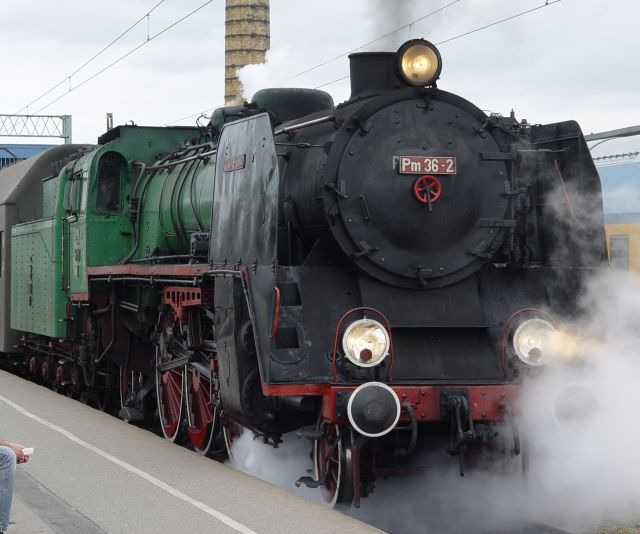|
PKP Class Ol49
PKP class Ol49 is a class of ordinary passenger (O) 2-6-2 (l) steam engine designed in 1949 and used in Poland by the Polskie Koleje Państwowe (Polish State Railways) (PKP). A total of 116 were built between 1951 and 1954, 112 for the PKP and four for export to North Korea, by Fablok in Chrzanów. They replaced the older PKP class Ok1, Ok1 and PKP class Ok22, Ok22. Several examples are still in use, based out of Wolsztyn, while others have been mounted at various locations across Poland. See also *PKP classification system References * Further reading * Railway locomotives introduced in 1951 2-6-2 locomotives Polish State Railways steam locomotives, Ol49 Fablok locomotives Passenger locomotives Standard gauge locomotives of Poland {{poland-rail-transport-stub ... [...More Info...] [...Related Items...] OR: [Wikipedia] [Google] [Baidu] |
Fablok
Fablok is a Polish manufacturer of locomotives, based in Chrzanów. Until 1947 the official name was ''First Factory of Locomotives in Poland Ltd.'' ( pl, Pierwsza Fabryka Lokomotyw w Polsce Sp. Akc.), Fablok being a widely used syllabic abbreviation of ''Fabryka Lokomotyw'', among others as the company's telegraphic address. It is now named "BUMAR - FABLOK S.A. (corporation)". Fablok is located in the town of Chrzanów in Lesser Poland. As of 2009, Fablok no longer builds new locomotives. History Early years 1919-1939 Fablok was established in 1919. A year later a contract was signed with the Polish government to supply 1,200 steam locomotives within ten years to the Polish State Railways (PKP). The first locomotive was delivered on 7 April 1924. In 1931, the first locomotive was exported to the Bulgarian State Railways. During 1935 and 1936, five electric locomotives were built under license from Metropolitan-Vickers. In 1935–1936, Fablok produced five Luxtorpedas (fast ... [...More Info...] [...Related Items...] OR: [Wikipedia] [Google] [Baidu] |
Wolsztyn
Wolsztyn (german: Wollstein) is a town in western Poland, on the western edge of Greater Poland Voivodeship. It is the seat of Wolsztyn County, and of the smaller administrative district of Gmina Wolsztyn. Geography The town is situated within the historic Greater Poland region, located on the small Dojca river, a headstream of the Obra, about southwest of Poznań. The municipal area includes a large lake ('; Wolsztyn Lake), next to which is a palace built in Classical style in the early 20th century, now used as a hotel and restaurant, and a park. Nearby tourist destinations include the Pszczew Landscape Park and the Przemęt Landscape Park. History The current settlement was established about 1285 on a causeway across the swampy Dojca River, probably by Cistercian monks descending from Obra Abbey. It developed as a centre of wool trade and cloth manufacturing on the road from Poznań to Lusatia, vested with market rights in 1424. Wolsztyn's town privileges were con ... [...More Info...] [...Related Items...] OR: [Wikipedia] [Google] [Baidu] |
Fablok Locomotives
Fablok is a Polish manufacturer of locomotives, based in Chrzanów. Until 1947 the official name was ''First Factory of Locomotives in Poland Ltd.'' ( pl, Pierwsza Fabryka Lokomotyw w Polsce Sp. Akc.), Fablok being a widely used syllabic abbreviation of ''Fabryka Lokomotyw'', among others as the company's telegraphic address. It is now named "BUMAR - FABLOK S.A. (corporation)". Fablok is located in the town of Chrzanów in Lesser Poland. As of 2009, Fablok no longer builds new locomotives. History Early years 1919-1939 Fablok was established in 1919. A year later a contract was signed with the Polish government to supply 1,200 steam locomotives within ten years to the Polish State Railways (PKP). The first locomotive was delivered on 7 April 1924. In 1931, the first locomotive was exported to the Bulgarian State Railways. During 1935 and 1936, five electric locomotives were built under license from Metropolitan-Vickers. In 1935–1936, Fablok produced five Luxtorpedas (fas ... [...More Info...] [...Related Items...] OR: [Wikipedia] [Google] [Baidu] |
Polish State Railways Steam Locomotives
Polish may refer to: * Anything from or related to Poland, a country in Europe * Polish language * Poles Poles,, ; singular masculine: ''Polak'', singular feminine: ''Polka'' or Polish people, are a West Slavic nation and ethnic group, who share a common history, culture, the Polish language and are identified with the country of Poland in C ..., people from Poland or of Polish descent * Polish chicken * Polish brothers (Mark Polish and Michael Polish, born 1970), American twin screenwriters Polish may refer to: * Polishing, the process of creating a smooth and shiny surface by rubbing or chemical action ** French polishing, polishing wood to a high gloss finish * Nail polish * Shoe polish * Polish (screenwriting), improving a script in smaller ways than in a rewrite See also * * * Polonaise (other) {{Disambiguation, surname Language and nationality disambiguation pages ... [...More Info...] [...Related Items...] OR: [Wikipedia] [Google] [Baidu] |
Railway Locomotives Introduced In 1951
Rail transport (also known as train transport) is a means of transport that transfers passengers and goods on wheeled vehicles running on rails, which are incorporated in tracks. In contrast to road transport, where the vehicles run on a prepared flat surface, rail vehicles (rolling stock) are directionally guided by the tracks on which they run. Tracks usually consist of steel rails, installed on sleepers (ties) set in ballast, on which the rolling stock, usually fitted with metal wheels, moves. Other variations are also possible, such as "slab track", in which the rails are fastened to a concrete foundation resting on a prepared subsurface. Rolling stock in a rail transport system generally encounters lower frictional resistance than rubber-tyred road vehicles, so passenger and freight cars (carriages and wagons) can be coupled into longer trains. The operation is carried out by a railway company, providing transport between train stations or freight customer facili ... [...More Info...] [...Related Items...] OR: [Wikipedia] [Google] [Baidu] |
PKP Classification System
PKP classification system (Polish locomotive designation) is a system of assigning letters and numbers to series and individual locomotives used by the PKP - Polish national railroad operator. The system was introduced for the steam stock by the Ministry of Railways on 3 November 1922, shortly after Poland regained her independence (1918) when the Polish railroads inherited a variety of German, Austrian and Russian steam locomotives, each with its own type convention. It was put into use in 1923–1926 years. The adopted solution allows telling the locomotive type (passenger/freight/mixed), wheel arrangement, origin and some other information from the type designation. After World War II a similar system was also adapted for diesel and electric locomotives. Electric and diesel locomotives In the case of electric and diesel locomotives, and multiple units, a designation consists of two capital letters and two digits, without a space between letters and digits. The first letter E ... [...More Info...] [...Related Items...] OR: [Wikipedia] [Google] [Baidu] |
Żukowo Wschodnie Fablok Ol49-69
Żukowo ( csb, Żukòwò, german: Zuckau, la, Sucovia) is a town in the Kartuzy County, in the Pomeranian Voivodeship of northern Poland, in the geographical region of Kashubia, with 6,236 inhabitants (2005). It is located along the Radunia river, in the historic Pomerelia, about southwest of Gdańsk. History Żukowo was the site of a Premonstratensian (Norbertine) monastery established about 1209 by Duke Mestwin I of Pomerania. The church features alabaster figures made in England. Here the Kashubian embroidery is still in use. In Kashubia decorated women's bonnets were called ''zlotnice''. Norbertine nuns in Żukowo made them in the 18th century. The embroidery was made with silver or gold threads. Women's bonnets designing contains motifs similar to church embroideries and this were based on baroque style. The nuns were teaching noblemen's and rich Kashubian peasants' daughters how to make embroidery – one of them was Marianna Okuniewska from Żukowo (born 1818). Żuk ... [...More Info...] [...Related Items...] OR: [Wikipedia] [Google] [Baidu] |
PKP Class Ok22
PKP class Ok22 is a class of ordinary passenger (O) 4-6-0 (k) steam locomotive designed in 1922 for Polskie Koleje Państwowe (Polish State Railways, PKP). It was the first locomotive designed in Poland after World War I, so the design work was done jointly with Hanomag, based on the Prussian P 8 ( PKP class Ok1) History Introduction The first five engines were built in Germany by Hanomag in 1923. Polish production started in 1928 and lasted until 1934 after which 185 locomotives had been manufactured by Fablok in Chrzanów. The first Polish-built locomotive (Ok22-6) was ready on December 31, 1928. Polish versions of the locomotive bore some improvements and changes compared with German ones, and were similar to PKP class Ty23. Ok22 locomotives were the first on the PKP to be equipped with electric lights. Wartime After the German invasion of Poland in World War II, most Ok22 locomotives were taken into the Deutsche Reichsbahn fleet as 38 4501 to 38 4630. Present day Only two ... [...More Info...] [...Related Items...] OR: [Wikipedia] [Google] [Baidu] |
2-6-2
Under the Whyte notation for the classification of steam locomotives, represents the wheel arrangement of two leading wheels, six coupled driving wheels and two trailing wheels. This arrangement is commonly called a Prairie. Overview The majority of American 2-6-2s were tender locomotives, but in Europe tank locomotives, described as , were more common. The first 2-6-2 tender locomotives for a North American customer were built by Brooks Locomotive Works in 1900 for the Chicago, Burlington and Quincy Railroad, for use on the Midwestern prairies. The type was thus nicknamed the Prairie in North American practice. This name was often also used for British locomotives with this wheel arrangement. As with the 2-10-2, the major problem with the 2-6-2 is that these engines have a symmetrical wheel layout, with the centre of gravity almost over the centre driving wheel. The reciprocation rods, when working near the centre of gravity, induce severe side-to-side nosing which results in ... [...More Info...] [...Related Items...] OR: [Wikipedia] [Google] [Baidu] |
PKP Class Ok1
Ok1 is the Polish designation of a Prussian steam locomotive, the Prussian P 8, used on Polish State Railways. Production of the P 8 lasted from 1908 until 1928 and this locomotive was used on practically all European railway lines. After the end of World War I, 192 Class P 8 engines were handed over as a reparation to Poland, including two machines for Free City of Danzig, where they were re-designated as Class Ok1 locomotives (numbers: Ok1-1 to Ok1-190 and Ok1-1Dz and 2Dz for Danzig machines).Terczyński, P. (2003), pp. 52, 56 Since the class was considered successful, further 65 locomotives were built in Germany at Polish order in 1922-1923 (designated Ok1-201 to 265). During World War II World War II or the Second World War, often abbreviated as WWII or WW2, was a world war that lasted from 1939 to 1945. It involved the vast majority of the world's countries—including all of the great powers—forming two opposing ... all the locomotives were captured by t ... [...More Info...] [...Related Items...] OR: [Wikipedia] [Google] [Baidu] |



